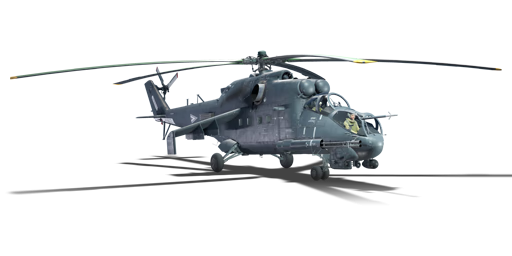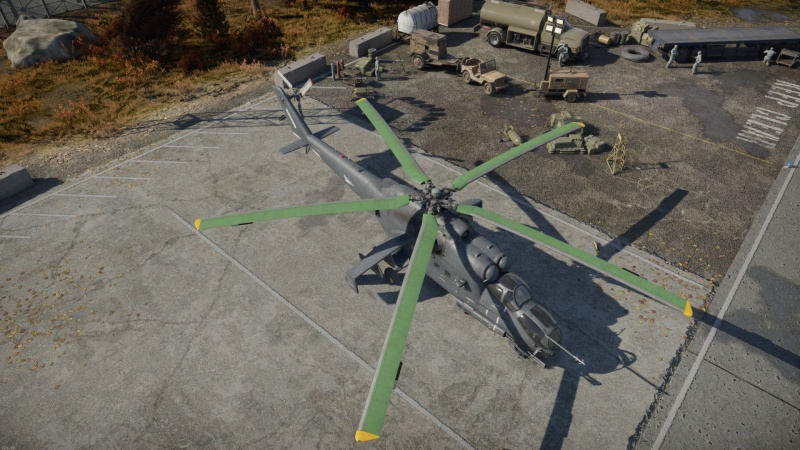Mi-24P (Italy)
Contents
Description
The Mi-24P (NATO Code: Hind-F) is a rank VI Soviet attack helicopter with a battle rating of 10.0 (AB) and 9.7 (RB/SB). It was introduced in Update "sons of attila".
The Mi-24P is very similar to the previous Mi-24V, having the same airframe, technology, and weapons. The only difference is the gun armament: the chin-mounted Yak-B gatling gun has been replaced with a fixed GSh-30-2 cannon mounted on the right side of the nose. This is the same type of cannon mounted on the Su-25 attack jet, another Soviet "flying tank". Although it is difficult to aim, a quick burst from the cannon can shred lightly armored vehicles. Thus, the Mi-24P is a sidegrade to the Mi-24V, having more anti-ground ability at the cost of a minor amount of anti-air capability.
General info
Flight performance
Describe how the helicopter behaves in the air. Speed, manoeuvrability, acceleration and allowable loads - these are the most important characteristics of the vehicle.
| Characteristics | Max speed (km/h at _,___ m) |
Max altitude (metres) | |
|---|---|---|---|
| AB | RB | ||
| Stock | 193 | 181 | 16236 |
| Upgraded | 223 | 208 | |
Survivability and armour
The Mi-24P Hind is protected by 4 mm steel plates near the cockpit area, and the engine area, giving it decent protection against small MG fire, and shrapnel. The cockpit is protected by 60 mm of bulletproof glass, though it's only on the front and the pilot can be knocked out easily with a spray of MG fire. Same can be applied to the gunner too. It can survive direct shots, especially if the enemy hits the crew compartment due to the empty space of that area, though there is fuel underneath the crew compartment and can be set on fire if it is hit. HE/HE-VT, ATGMs, SAMS and AAMs are usually detrimental to the Hind and can bring it down easily, though MANPADs such as Stingers and Iglas can be tanked as they have lower explosive power, but they can render the Hind critically damaged/disabled and needing to return to base.
Modifications and economy
Basic → Reference
AB7 568 → 14 038
RB3 295 → 6 112
SB4 563 → 8 464
Total cost of modifications301 600
444 000
Talisman cost2 400
Crew training280 000
Experts990 000
Aces2 200
Research Aces890 000
Reward for battleAB / RB / SB
100 / 290 / 430 %
214 / 214 / 214 %
Armaments
Offensive armament
The Mi-24P (Italy) is armed with:
- A choice between four presets:
- 1 x 30 mm GSh-30-2K cannon (250 rpg) + 192 x countermeasures
- 1 x 30 mm GSh-30-2K cannon + 192 x countermeasures + HIRSS
- 1 x 30 mm GSh-30-2K cannon + 192 x countermeasures + HIRSS + IRCM
Suspended armament
The Mi-24P (Italy) can be outfitted with the following ordnance:
| Default weapon presets | |
|---|---|
| |
Usage in battles
The Mi-24P can be used very similarly to the Mi-24V and will function identically in standoff situations where the 9M114 Shturm ATGMs or S-24 rockets would be used from afar. The powerful cannon is helpful when making aggressive attack runs, either as a first choice or when moving closer to the battlefield after expending ATGMs. Even with ballistic computer assistance, it may take some practice to use the cannon effectively. Line up the Mi-24P for a gun run in advance and start firing from some distance away to avoid needing heavy course corrections.
The R-60/R-60M missiles are somewhat more important for the Mi-24P than they are on the Mi-24V. The cannon is likely to evaporate any aircraft it touches, but an agile opponent can dodge its fire. It is difficult to hit jets with it unless they linger in a head-on. Even in helicopter dogfights, the contemporary AH-1F for example has superior agility and a turreted 20 mm gatling cannon that can perforate the Mi-24P in turn, so having a couple of missiles on hand to dispatch aircraft with a couple of button presses is more helpful than ever.
Keep in mind that the kind of light vehicles that the Mi-24P's cannon is most effective on are often quite good at fighting helicopters in their own right. For SPAA vehicles their effectiveness against nearby air targets is a given, but IFVs with optical tracking, proximity fused/airburst rounds, and/or proximity-fused ATGMs can also send the Mi-24P back to the hangar without much trouble. The Hind family may have a reputation as "flying tanks", but they may more accurately be considered "flying IFVs" given their troop transport capability and limited protection. Thus, in War Thunder the Mi-24P can borrow the IFV tactic of using its great speed to zip in and out of the battlefield and attack from unexpected directions.
Pros and cons
Summarise and briefly evaluate the vehicle in terms of its characteristics and combat effectiveness. Mark its pros and cons in the bulleted list. Try not to use more than 6 points for each of the characteristics. Avoid using categorical definitions such as "bad", "good" and the like - use substitutions with softer forms such as "inadequate" and "effective".
Pros:
- 30 mm cannon provides great offensive/defensive capabilities against lightly armoured vehicles and air targets
- Very flexible payload
- R60M missile is very effective against close flying targets
- 9M114 Shturm ATGM can be fired from 5 km away, making most AA useless
- Has access to RWR, HIRSS, IRCM, flares/chaff and a ballistic computer
- Can easily reach 300 km/h with a full payload
- Armoured plates increase protection for the engine, transmission and the crew
Cons:
- Large profile and lack of manoeuvrability makes it an easy target
- Fixed 30 mm cannon may be hard to aim at air targets for inexperienced players
- Lacks thermal and night vision sight for gunner
History
Mi-24 development started in the early 1960s by Mil Moscow Helicopter Plant company, with a very controversial start. Several Soviet officers believed that conventional weapons were a safer choice to spend money in. But seeing the successful use of armed helicopters in Vietnam by the US Army convinced the Soviets about the capacities of armed helicopters, thus showing support for Mil's project.
Two prototypes were eventually created: a 7-ton single-engine design and a 10.5-ton twin-engined one. In May 1968, the twin-engine mock up was chosen for further development. The project made its first flight in September 1968, and entered service bearing the name of Mi-24 in 1972.
The Mi-24P variant was a later development of the Mi-24D, featuring a new fixed 30 mm twin-barrel GSh-30-2K cannon instead of the old 12.7 mm machine gun turret.
The helicopter first saw combat service in Ogaden War and in the Chadian-Libyan Conflict, used by the Ethiopian and Libyan forces respectively. The Mi-24 proved to be very effective in ground infantry support duties, even managing to save a company of infantry while out of ammunition, scaring the rebels by manoeuvring aggressively towards them! It was very popular among the ground troops.
The Mi-24P's modernized variant, the Mi-35M, is still in use to this day in various countries, including Russia.
Media
Excellent additions to the article would be video guides, screenshots from the game, and photos.
See also
Links to the articles on the War Thunder Wiki that you think will be useful for the reader, for example:
- reference to the series of the helicopter;
- links to approximate analogues of other nations and research trees.
External links
Paste links to sources and external resources, such as:
- topic on the official game forum;
- other literature.
| Mil Moscow Helicopter Plant | |
|---|---|
| Attack | Mi-4AV |
| Mi-8AMTSh · Mi-8AMTSh-VN · Mi-8TV | |
| Mi-24A · Mi-24P · Mi-24V | |
| Mi-28N · Mi-28NM | |
| Mi-35M | |
| Export | ◊Mi-8TB |
| ▂Mi-24D · ◔Mi-24D · ◔Mi-24V · ◔Mi-24P · ◊Mi-24P · ◄Mi-24P HFS 80 · Superhind | |
| Mi-28A | |
| ▄Mi-35M | |
| Italy helicopters | |
|---|---|
| Utility | AB 205 A-1 · A.109EOA-2 |
| Attack | A-129 International (p) · A129CBT · AH-129D · T129 |
| Hungary | ◔Mi-24D · ◔Mi-24V · ◔Mi-24P |





